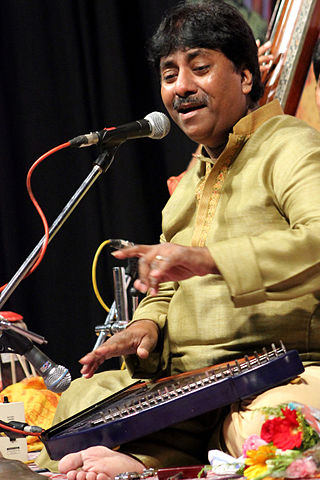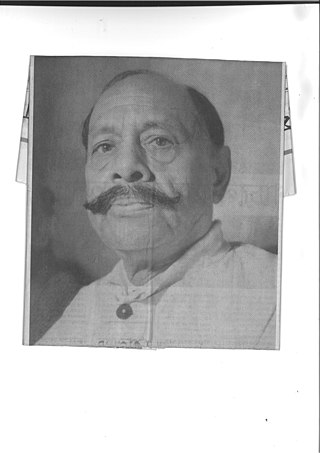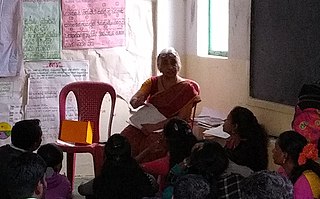Related Research Articles
Kirana gharana is one of the Indian classical khyal gharanas, and is concerned foremost with intonation of notes (swara).

Rashid Khan was an Indian classical musician in the Hindustani tradition. He belonged to the Rampur-Sahaswan gharana, and was the great-grandson of gharana founder Inayat Hussain Khan. He was married to Soma Khan.
Sahaswan is a city and a municipal board in Budaun district in the Indian state of western Uttar Pradesh. It is also an administrative Block, 0177 is the block code.

Ustad Faiyaz Khan was an Indian classical vocalist, an exponent of the Agra gharana of Hindustani classical music. According to SwarGanga Music Foundation website, "By the time he died at Baroda, he had earned the reputation of being one of the greatest and most influential vocalists of the century."
Ustad Ahmed Jan Khan "Thirakwa" was an Indian tabla player, commonly considered the pre-eminent soloist among tabla players of the 20th century, and among the most influential percussionists in the history of Indian Classical Music.
The Gwalior Gharana is one of the oldest Khyal Gharana in Indian classical music. The rise of the Gwalior Gharana started with the reign of the Mughal emperor Akbar (1542–1605).

Ustad Ghulam Sadiq Khan was an Indian classical vocalist. He belonged to the Rampur-Sahaswan gharana.

Rampur State was a 15 gun-salute princely state of British India. It came into existence on 7 October 1774 as a result of a treaty with Oudh. Following independence in 1947, Rampur State and other princely states of the area, such as Benares and Tehri Garhwal were merged into the United Provinces. Rampur state had its capital in Rampur city and its total area was 945 sq miles. Rampur state was founded by Ali Mohammad Khan's younger son Faizullah Khan.
Qutub Bakhsh, more commonly known as Tanras Khan, was an Indian musician of the Hindustani Classical tradition known for being a luminary of the Delhi Gharana.(House of Delhi classical musicians). He was a court musician and music teacher to the last Mughal emperor Bahadur Shah Zafar II.
Ustad Nissar Hussain Khan was an Indian classical vocalist from the Rampur-Sahaswan gharana. He was a disciple and son of Fida Hussain Khan and after a long and illustrious career was awarded the Padma Bhushan in 1971.
Ustad Inayat Hussain Khan (1849–1919) was an Indian classical music vocalist, and the founder of Rampur-Sahaswan gharana.
Sumati Mutatkar was an Indian classical music vocalist and musicologist from the Agra gharana of Hindustani classical music, and a Professor of Department of Music in University of Delhi.

Ustad Ghulam Mustafa Khan was an Indian classical musician in the Hindustani classical music tradition, belonging to the Rampur-Sahaswan Gharana.

Shanno Khurana is a noted Indian classical vocalist and composer, from the Rampur-Sahaswan gharana of Hindustani classical music. A disciple of the doyen of the gharana, Ustad Mushtaq Hussain Khan, she is known for performing rare bandish and raag, though her singing style includes genres like khayal, tarana, thumri, dadra, tappa, to chaiti and bhajan. Born and brought up in Jodhpur, she started singing on All India Radio in 1945 in Lahore, later shifted to Delhi, where she continued her singing on All India Radio, Delhi and in concerts and music festivals. She also pursued music education, finally earning her M.Phil. and PhD in music from the Kairagarh University, and has undertakes extensive research on folk music of Rajasthan.
Naina Devi also known as Naina Ripjit Singh, was Indian vocalist of Hindustani classical music, most known for her thumri renditions, though she also sang dadra and ghazals. She was a music producer at All India Radio and later with Doordarshan. She started her musical training under Girja Shankar Chakravarty in her teens, later restarted it with Ustad Mushtaq Hussain Khan of Rampur-Sahaswan gharana and Rasoolan Bai of Benaras gharana, in the 1950s. Born in an aristocratic family in Kolkata, she was married into the royal family of Kapurthala State at age 16, and was started singing in concerts only after her husband died in 1949, and she moved to Delhi.
Ustad Bade Inayat Hussain Khan (1837–1923) was a classical Indian vocalist who belonged to the famous Gwalior Gharana. He was the son of Haddu Khan who was the maternal grandson of Nathan Pir Bakhsh, the founder of Gwalior Gharana. He was the first person to introduce Bol Bant in Khayal Gayki. His Khayal Gayki is used in all the Gharanas. Haddu Khan's son Bade Inayat Hussain Khan (1852–1922) was a singer who expanded the Gwalior style from the methodical form it followed to the emotional style that he preferred.
Hafeez Ahmed Khan was an Indian classical musician of Hindustani classical music. He is known as one of the leading exponents of the Rampur-Sahaswan gharana, a musical school popular in the northern parts of the Indian state of Uttar Pradesh. He learnt music in gurukul system and pursued his academic studies the conventional way, secured a master's degree in politics and taught at the University of Minnesota. He was a deputy director of the All India Radio and the vice chancellor of the Indira Kala Sangeet University, the only Indian university dedicated to music. He mentored many disciples such as Rajendra Prasanna, Roma Rani Bhattacharya, Sakuntala Narasimhan and Subhendu Ghosh and acted in a German movie on the life of Tansen, by name, The Rain Maker. He was a recipient of the 1996 Sangeet Natak Akademi Award. The Government of India awarded her the fourth highest civilian honour of the Padma Shri in 1991. Hafeez Ahmed Khan, who was married to the daughter of renowned singer, Nissar Hussain Khan, died in 2006.

Ustad Mushtaq Hussain Khan (1878–1964) was an Indian classical vocalist. He belonged to the Rampur-Sahaswan gharana.
Nazir Khan, more commonly known as "Ghagge" Nazir Khan or Jodhpurwale Nazir Khan, was an Indian classical singer and, along with his elder brother Wahid Khan, founded the Mewati gharana, later popularized by Pandit Jasraj.

Sakuntala Narasimhan is an Indian journalist, consumer rights activist, and classical vocalist from the Rampur-Sahaswan gharana of Hindustani classical music. She was a disciple of Hafeez Ahmed Khan and is the only vocalist in India to have performed in the National Programme of Music organized by Doordarshan and All India Radio in both Carnatic and Hindustani styles. She was trained in Carnatic classical music by vocalists Musiri Subramania Iyer and Thanjavur Brinda. She is also the only artiste doing a “self-jugalbandi” juxtaposing the two styles.
References
- 1 2 3 4 "Inayat Hussain Khan - Founder of Rampur-Sahaswan gharana (profile)". ITC Sangeet Research Academy website. Archived from the original on 23 May 2012. Retrieved 3 January 2024.
- ↑ "Notes from another time: Sakuntala Narasimhan's book on the Rampur-Sahaswan gharana captures the cultural history of a period". The Hindu newspaper. 16 September 2006. Archived from the original on 29 June 2013. Retrieved 3 January 2023.
- ↑ S. Kashif Ali (29 May 2009). "Quietly fading into oblivion". The Hindu newspaper. Archived from the original on 29 August 2009. Retrieved 3 January 2023.